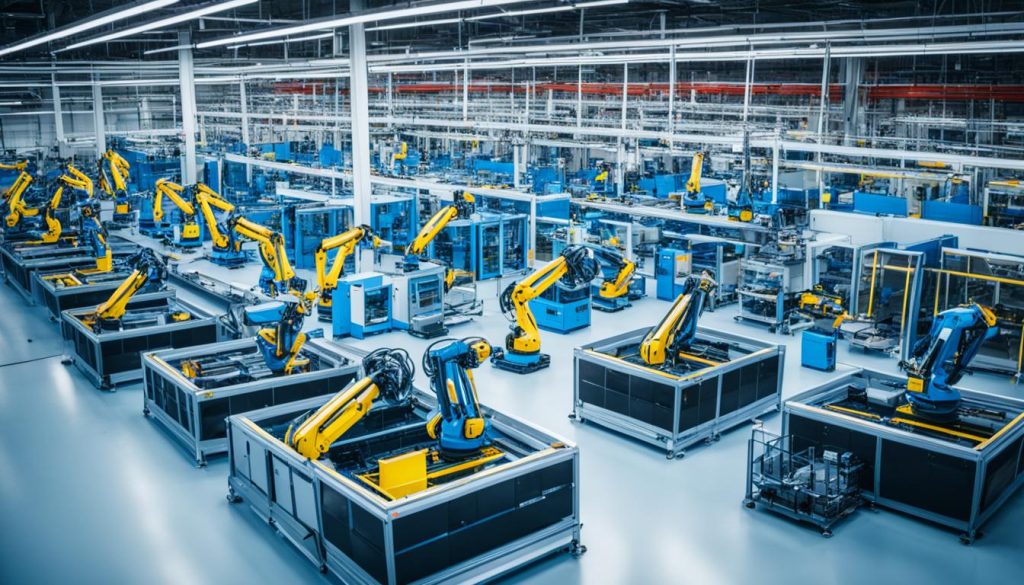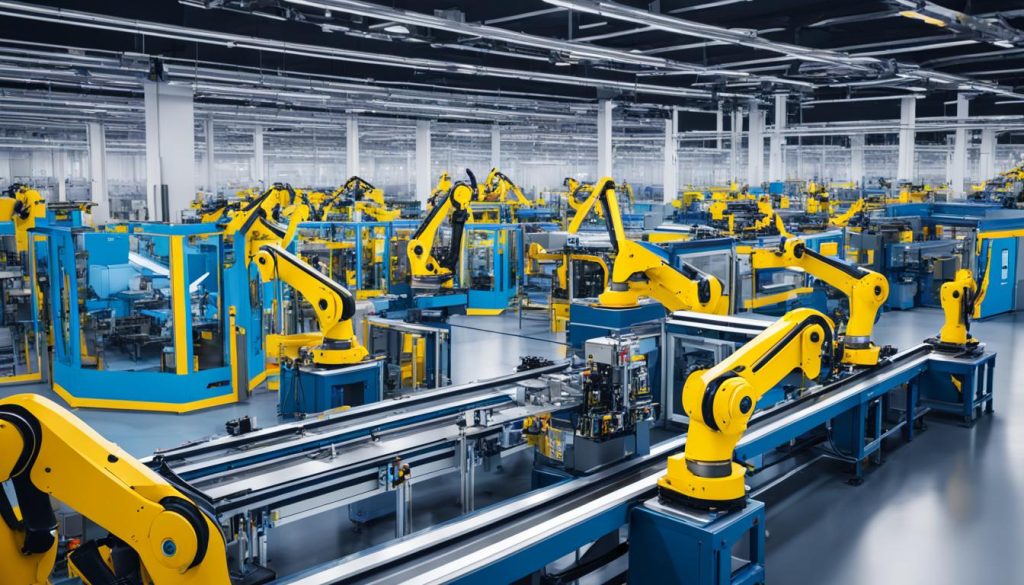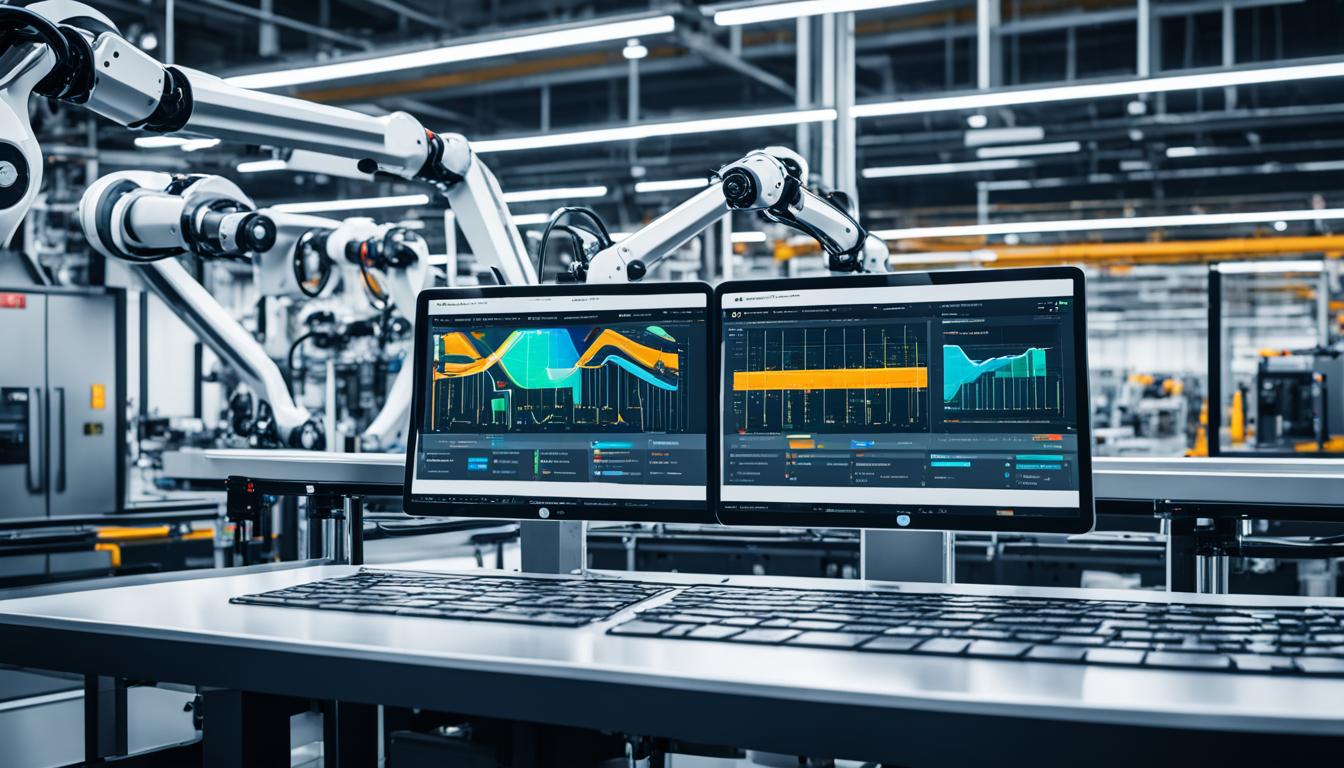The landscape of manufacturing is in constant flux, influenced by powerful waves of technological advancements. As a stakeholder in this dynamic sector, you’re likely witnessing the transformative effect of digital transformation in manufacturing. It’s a movement reshaping production from its core, driving efficiency, and leading to the emergence of smart factory solutions. The ability for manufacturers to stay competitive now parallel to their agility in embracing these modern technologies. Let’s navigate the terrain of technology adoption in manufacturing to understand how it is carving out tomorrow’s industrial milestones today.
Key Takeaways
- The significance of staying current with technological evolution in manufacturing.
- Understanding the impact of digital transformation in enabling smarter, more efficient production processes.
- Acknowledging the growth of smart factory solutions as a benchmark for industry leaders.
- The role of technology adoption as an essential strategy for maintaining market competitiveness.
- Insights into how integrating advanced technology is pivotal for the scalable, sustainable growth of manufacturing enterprises.
Exploring the Industrial Shift Towards Manufacturing Technology Trends
The manufacturing landscape is undergoing a profound transformation, driven by innovative technologies that redefine efficiency and productivity. As you move forward in the digital age, understanding these manufacturing technology trends is crucial for any business aiming to stay competitive. These are not mere upgrades but foundational shifts that promise to reshape the future of manufacturing.
Defining the Latest Trends in Manufacturing Technology
Recent technological advancements in production have ushered in a new era of automation and smart manufacturing. Advanced robotics, Internet of Things (IoT) connectivity, and Artificial Intelligence (AI)-driven processes are at the forefront, paving the way for more adaptable, complex systems known as Industry 4.0. Moreover, additive manufacturing, such as 3D printing, has evolved from prototyping to full-scale production capabilities, demonstrating the potential to revolutionize manufacturing logistics and supply chain management.
How Manufacturing Technology Trends are Shaping the Industry
These technology trends embody transformative potential, creating smart factories where interconnected machines communicate and self-optimize. The implementation of Industry 4.0 strategies is enabling manufacturers to enjoy enhanced agility, reduced waste, and improvements in safety and productivity. Data analytics now informs every stage of the manufacturing process, providing insights that fuel continuous improvement and customizations that were once unthinkable.
Exploring Examples of Emerging Manufacturing Technologies
To truly grasp the scale of change, let’s observe real-world applications. Consider the automotive industry, where manufacturers like Tesla are integrating sophisticated robotics and data systems to streamline assembly lines. Or look at GE’s use of predictive maintenance technology, which anticipates equipment failures before they occur, minimizing downtime and extending machinery longevity.
| Technology | Application | Benefit |
|---|---|---|
| Advanced Robotics | Assembly and material handling | Increased precision, speed, and safety |
| IoT Connectivity | Real-time monitoring of equipment | Improved efficiency and maintenance planning |
| AI-Driven Processes | Quality control and optimization | Enhanced product quality and reduced operational costs |
| Additive Manufacturing | Production of complex parts | Supply chain flexibility and on-demand manufacturing |
| Data Analytics | Process analysis and improvement | Data-driven decision making for continuous improvement |
This synergy between cutting-edge manufacturing technologies and Industry 4.0 implementation strategies is not only boosting productivity but also providing companies with the resilience to adapt swiftly to changing market demands and unexpected challenges. As you forge ahead, these technological innovations serve as both the tools and the pathways to a more sophisticated, efficient, and responsive manufacturing sphere.
Industry 4.0 Implementation Strategies for Modern Manufacturers
Embarking on the path to Industry 4.0 can be an intricate process for manufacturers. The transition encapsulates more than the mere adoption of new technologies; it demands a holistic reimagining of operational processes. To navigate this transition, understanding the core pillars that support Industry 4.0 is crucial, as well as having a robust action plan to guide the technological integration in the factory. By exploring case studies, you’ll witness the transformative effects of digital transformation in manufacturing on those who have successfully adopted it.
Understanding the Four Pillars of Industry 4.0
The four main pillars of Industry 4.0 – Cyber-Physical Systems, Internet of Things (IoT), Big Data & Analytics, and Autonomous Robots – are critical for establishing a connected manufacturing landscape. Each pillar plays a specific role in the orchestration of a digitized factory floor, allowing for real-time data collection, analysis, and automation. A concise understanding of these components is essential for their effective interplay and creating a resilient tech infrastructure.
Developing an Action Plan for Technology Transition
Your strategies for implementing Industry 4.0 should begin with a comprehensive evaluation of your current manufacturing systems and processes. This appraisal forms the basis of a structured action plan that guides you through technology selection, training of personnel, and the integration of systems. An incremental approach, focusing on achieving small milestones and continuous improvement, often yields the most successful outcomes, minimizing disruptions and maximizing employee adaptation.
Case Studies: Successful Industry 4.0 Strategies in Manufacturing
Learning from others’ successes can be a blueprint to your own. By examining case studies of those who have flourished in adopting Industry 4.0 strategies, you can identify best practices that resonate with your unique operational needs. These real-world examples provide insights into not only the compelling benefits, such as heightened operational efficiency and competitive edge but also the challenges encountered and strategies used to overcome them.
Remember, Industry 4.0 doesn’t signify a destination but an ongoing journey of innovation and growth. Your manufacturing operation can seize this opportunity to reinvent itself, accelerating towards a future where adaptability and digital prowess are cornerstones of industry leadership.
Embracing Digital Transformation in Manufacturing
The landscape of manufacturing is being reshaped by the relentless march of digital transformation. In an industry where efficiency and speed are paramount, the introduction of data analytics and automation is not simply about keeping up. It is about vaulting ahead of the competition and embracing the future. Your journey through the digital realm could well be the deciding factor between leading the pack or trailing behind.

Smart data utilization, through data analytics for manufacturing efficiency, provides an unparalleled clarity into your operations. The information gleaned from various sensors and inputs can expose inefficiencies that were previously invisible to the naked eye. But data is just numbers unless acted upon. This is where automation in manufacturing processes comes in—turning insights into action seamlessly and with precision.
Consider the following real-world application: A manufacturing plant implements sensors throughout the production line. These sensors collect data on operational parameters such as speed, temperature, and machine performance. Using advanced analytics, the plant not only monitors for anomalies but predicts them, scheduling maintenance before a breakdown occurs. Simultaneously, automated systems adjust settings in real-time to maintain optimal performance, a feat impossible for human operators to match in speed and accuracy.
| Aspect of Manufacturing | Impact of Digital Transformation |
|---|---|
| Operational Efficiency | Harness data-driven insights for real-time optimizations |
| Product Quality | Automated quality control ensures consistent excellence |
| Decision Making | Data analytics augments forecasting and strategic planning |
| Cost Reduction | Predictive maintenance and optimized resource usage save expenses |
A tangible illustration of the transformative power of these technologies is seen within the automotive industry. Major manufacturers have adopted robotic assembly lines not just because of the precision they offer, but also their ability to work tirelessly without the need for breaks. This has led to a surge in productivity and a significant decrease in production time, all while maintaining a high standard of quality.
Roll out the advanced manufacturing practices into your factories, leveraging data analytics and automation as vital tools. They are not futuristic concepts but present-day necessities. Progress can only be delayed at one’s own peril; the moment to step into the digitally evolved manufacturing space is now. As you do, remember that the switch to these technologies is as much about cultural adaptation within your organization as it is about the technical overhaul.
Smart Factory Solutions: Revolutionizing Production Lines
The embrace of smart factory solutions is transforming how manufacturers think about production. With automation in manufacturing processes and technology integration in the factory, businesses are not just automating tasks—they are crafting ecosystems of interconnected devices and intelligence that redefine efficiency and agility.
The Role of IoT and AI in Smart Factories
In the heart of the smart factory, the Internet of Things (IoT) and Artificial Intelligence (AI) merge to create something remarkable. IoT serves as the digital nerve system, connecting machines, sensors, and workers, while AI provides the brainpower, analyzing vast amounts of data to make real-time decisions and predict maintenance needs before they become critical.

Building a Roadmap to Smart Manufacturing
Transitioning to smart manufacturing isn’t an overnight feat. It’s a journey that starts with a detailed roadmap tailored to your factory’s needs. Key milestones might include integrating IoT devices, adopting cloud storage, training employees on new systems, and implementing predictive analytics. Each step paves the way for the next, ensuring a smooth evolution towards an entirely connected and intelligent production landscape.
Overcoming the Barriers to Smart Factory Adoption
Resistance to change is a common hurdle in the adoption of smart factory innovations. Concerns about cybersecurity, data privacy, and the initial investment can stall progress. Yet, overcoming these barriers is essential, and it often involves educating stakeholders on the long-term benefits, ensuring robust security protocols, and delivering a phased approach to technological investment and adaptation.
The Impact of Technological Advancements in Production Efficiency
In the realm of manufacturing, the winds of change are propelled by technological advancements in production. This transformative power is felt most profoundly in the heightened levels of production efficiency across factories that have embraced change. As you have seen throughout this discussion, manufacturers who invest in technologies such as IoT-enabled devices or AI-driven systems are not just riding a wave of innovation—they are dictating the pace of their industry’s evolution. Industry leaders have reported substantial gains, including improved product quality, lower production costs, and a more expedient time-to-market. These are not just numbers on a balance sheet; they are real-world benefits that have bolstered the competitiveness of manufacturing firms.
Through data analytics for manufacturing efficiency, businesses unlock actionable insights that streamline processes and prevent wasteful practices. It transforms raw data into a strategic asset, leading to well-informed decisions and proactive improvements. Moreover, by integrating Industry 4.0 implementation strategies, manufacturers are positioning themselves at the forefront of a technological renaissance, automating and connecting operations in ways that were once inconceivable. These advancements cultivate an environment where constant improvement is not just a goal but an everyday reality, fostering an adaptive and resilient manufacturing sector.
Your take-away from this exploration of tech-enhanced manufacturing should be a recognition of the strategic necessity of technology adoption. It’s clear that maintaining a competitive edge in the manufacturing industry now demands not only the knowledge of emerging trends and solutions but also the courage to implement them. As you ponder your next steps, remember that the technologies discussed here are the engines of modern manufacturing, powering businesses towards a future where efficiency, quality, and innovation are inextricably linked. The journey towards a tech-empowered facility is complex, but the rewards—as evidenced by the successes outlined—are transformative and enduring.
FAQ
What does the digital transformation in manufacturing entail?
Digital transformation in manufacturing involves leveraging digital technologies to improve various aspects of manufacturing processes. This includes the adoption of smart factory solutions, automation, and data analytics to increase efficiency, reduce costs, and enhance product quality. It’s a fundamental shift from traditional practices to more advanced, digitally oriented operations.
How are manufacturing technology trends shaping the industry?
Manufacturing technology trends like the Internet of Things (IoT), artificial intelligence (AI), advanced robotics, and additive manufacturing are significantly altering the industrial landscape. They enable manufacturers to improve operational efficiency, customize production, and increase agility in responding to market demands, thus shaping the future of manufacturing.
What are the four pillars of Industry 4.0?
The four pillars of Industry 4.0 are interoperability, information transparency, technical assistance, and decentralized decision-making. These pillars support a smart manufacturing environment where machines, systems, and people are interconnected and communicate with each other, paving the way for more responsive and efficient production processes.
What is a smart factory and how does it function?
A smart factory is an advanced manufacturing facility equipped with IoT devices, AI, and automation technologies that collect and analyze data to optimize the manufacturing process. The integration of these tools creates a self-optimizing and autonomous production environment that can adapt to changes and improve over time.
What role do IoT and AI play in smart factories?
In smart factories, IoT devices collect vast amounts of data from equipment and production lines, while AI analyzes this data to identify patterns, predict maintenance needs, and optimize production flows. These technologies work together to enhance decision-making, reduce downtime, and improve overall manufacturing efficiency.
How can manufacturers develop an action plan for technology transition?
Manufacturers can develop an action plan for technology transition by first assessing their current capabilities and defining clear objectives for digital transformation. Then, they should prioritize their technology investments, design a phased implementation strategy, invest in workforce training, and establish metrics to monitor progress and success.
What are some barriers to smart factory adoption, and how can they be overcome?
Barriers to smart factory adoption include high initial costs, lack of skilled workers, data security concerns, and resistance to change. Manufacturers can overcome these barriers by creating a strong business case for investment, fostering a culture of continuous learning, implementing robust cybersecurity measures, and engaging all levels of the organization in the transition journey.
What benefits have manufacturers experienced from technological advancements in production?
Manufacturers embracing technological advancements have experienced numerous benefits such as increased operational efficiency, higher product quality, lower manufacturing costs, reduced production times, enhanced flexibility, improved safety, and better environmental sustainability. These improvements help manufacturers retain a competitive edge in the market.







